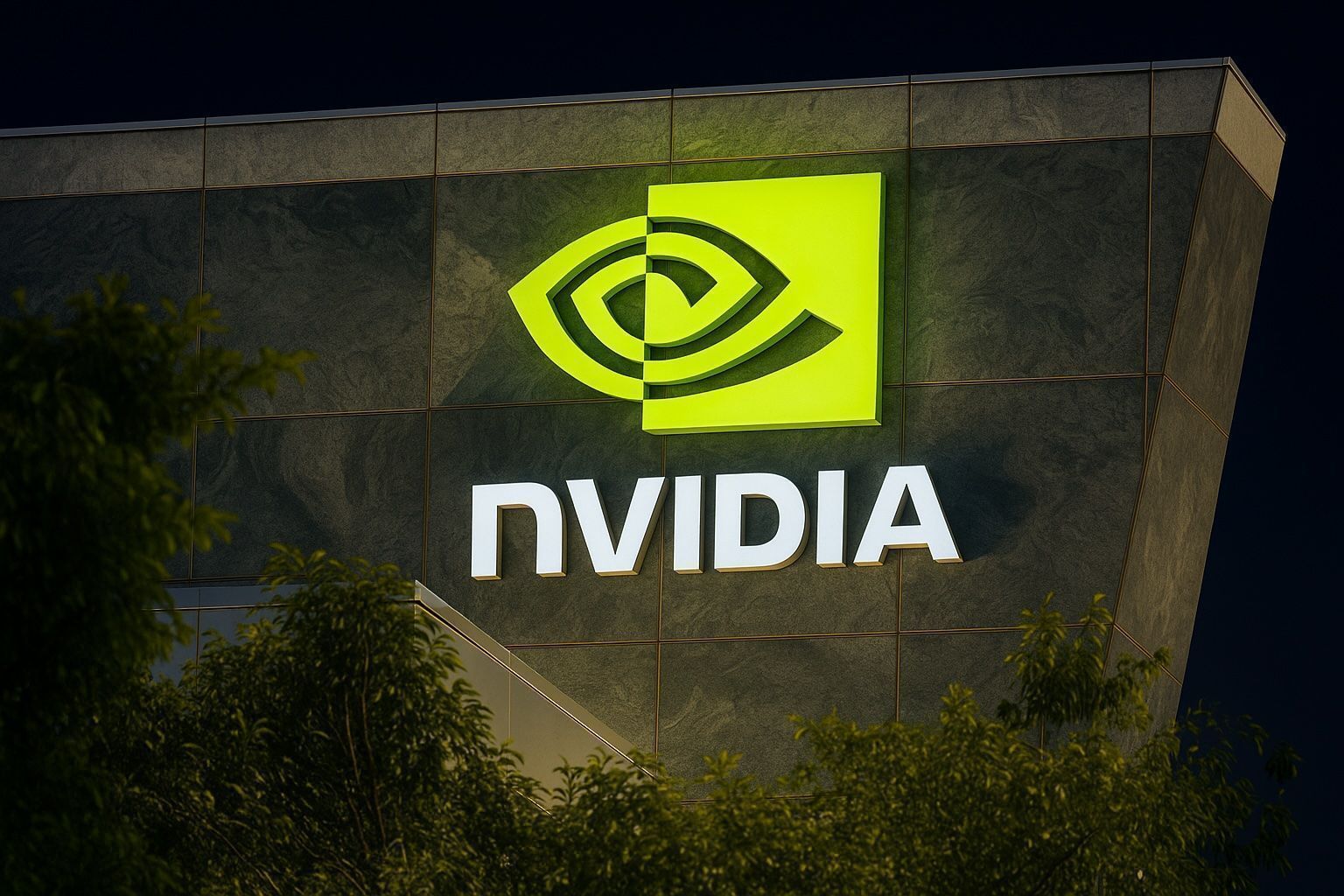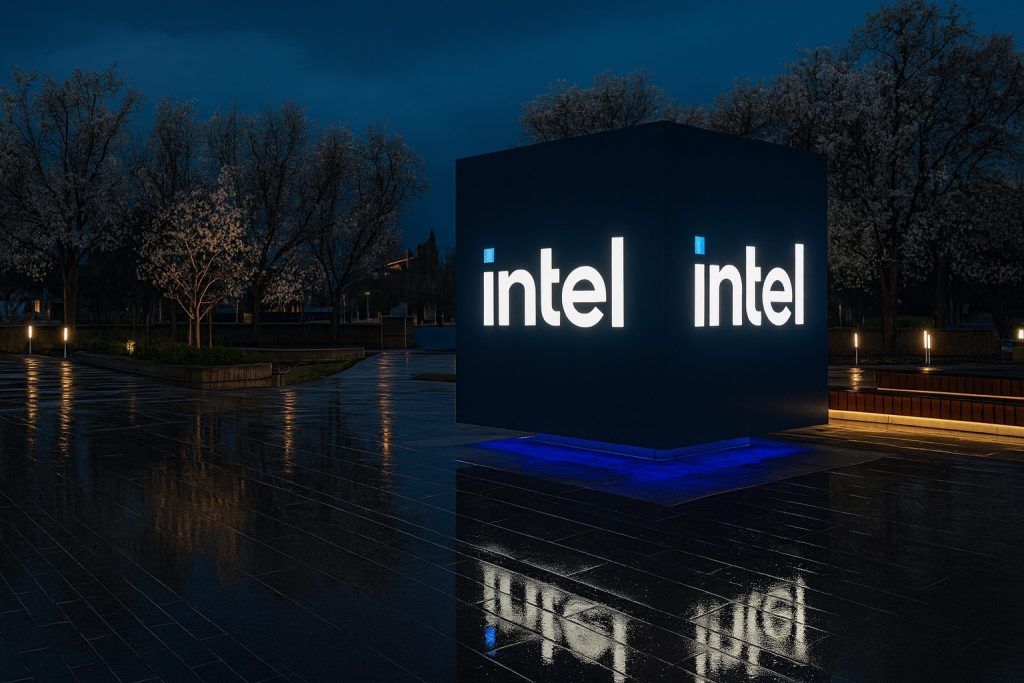- NVDA stock near all-time high: Nvidia’s share price is about $183 as of Oct. 18, 2025, after a volatile week. It hit a record ~$195 earlier in October before profit-taking and market jitters prompted a pullback [1].
- AI boom fueling massive growth: Explosive demand for Nvidia’s AI chips drove a 56% revenue surge last quarter to $46.7 billion [2]. Data-center sales alone hit $41 billion, boosting Nvidia’s market cap above $4.4 trillion – briefly the world’s most valuable company [3].
- New challenges emerge: Competition is rising – AMD scored headline AI chip wins (a major OpenAI deal and Oracle’s plan to use AMD AI chips) [4]. At the same time, U.S.–China tensions and export curbs on advanced chips threaten ~10–15% of Nvidia’s revenue that comes from China [5].
- Analysts bullish into earnings: Wall Street remains upbeat despite Nvidia’s high valuation. 38 of 47 analysts rate NVDA a “Buy” with average price targets around $210–$220 (~15% above current levels) [6]. Nvidia reports earnings on Nov. 19, and another blockbuster quarter is expected as AI demand stays red-hot [7].
NVDA Stock Rollercoaster Near Record Highs
Nvidia’s stock (NASDAQ: NVDA) has been on a wild ride this month. Shares reached an all-time high around $195.62 in early October amid frenzied buying, only to reverse sharply a few days later [8]. By Oct. 14, NVDA plunged over 4% in one session to roughly $180 as traders took profits and a broader tech sell-off hit high-flying names [9]. The pullback was short-lived – by the end of the week the stock rebounded to the low-$180s, showing resilience after the mid-week dip [10]. Nvidia is still trading near its peak levels, about 58% higher than a year ago, underscoring its status as the market’s premier “AI play” [11].
Market context: The recent volatility came as investors oscillated between enthusiasm for AI and worries about broader economic trends. In early October, renewed AI excitement added over $200 billion to semiconductor stocks within days [12]. But by mid-October, rising bond yields and strong bank earnings spurred a rotation out of pricey tech shares [13]. As a richly valued stock (around 50× earnings [14]), Nvidia proved especially sensitive to these sentiment swings. Short-term traders have been quick to “buy the dip” and just as quick to take profits, fueling a seesaw in NVDA’s price [15]. Still, demand for Nvidia remains intense due to its central role in the AI boom, keeping the company squarely in the market spotlight through every twist [16].
AI Boom Drives Record Sales and Value
Nvidia’s fundamentals are living up to the hype. In its latest quarter (FY Q2 2026, covering May–July 2025), revenue rocketed 56% year-over-year to $46.7 billion [17], dramatically above expectations. Remarkably, about 88% of those sales ($41.1 billion) came from data-center products – chiefly the GPUs powering generative AI models [18]. This growth spurt is unprecedented for a company of Nvidia’s size. Profits are soaring as well: gross margins sit above 72%, and net margins over 50% [19], reflecting huge economies of scale with surging AI chip orders.
Investors have rewarded this torrid growth by bidding Nvidia’s market capitalization to the stratosphere. In early October, Nvidia’s market cap briefly topped $4.5 trillion – overtaking every other company on the planet [20]. At around $4.4 trillion today, Nvidia is worth more than 10× AMD (~$350 billion) and 30× Intel (~$150 billion) [21]. This makes Nvidia not only the largest chip company ever, but a bellwether for the entire stock market’s mood [22]. Such a lofty valuation (about 53× trailing earnings, 33× forward) far exceeds industry averages [23], sparking debate about how much “AI hype” is already priced in [24].
What’s driving the boom: Nvidia’s ascent is built on real wins, not just investor euphoria. The company continues to launch new products and partnerships at a breakneck pace, cementing its leadership in AI. In recent weeks Nvidia rolled out its GeForce RTX 50-series graphics chips with AI-enhanced gaming performance, and it began shipping DGX Spark, billed as the world’s smallest AI supercomputer [25]. Nvidia also unveiled plans for next-gen “AI factories” – essentially massive data centers with cutting-edge 800-volt power infrastructure to support future AI models [26]. (That announcement sent shares of one supplier, Navitas Semiconductor, up 27% after its power chips were tapped for these systems [27].)
At the same time, Nvidia is locking in mega-deals to secure years of demand. In September, it struck a landmark partnership with OpenAI (creator of ChatGPT): Nvidia will supply OpenAI with 10 gigawatts of GPU computing capacity and even plans to invest up to $100 billion in OpenAI’s next-gen models as those AI data centers get built [28] [29]. This unprecedented arrangement blurs the line between vendor and investor – Nvidia is effectively funding one of its biggest customers so that OpenAI can buy even more Nvidia hardware.
The company is also collaborating with other tech giants. In a surprise move, Nvidia announced a $5 billion equity stake in Intel to co-develop advanced chips – an unusual alliance between rivals [30]. (That stake makes Nvidia one of Intel’s largest shareholders and sent Intel stock soaring +23% in a day [31] [32].) Nvidia’s CEO Jensen Huang said the two firms will jointly develop PC and data-center processors, aiming to combine Intel’s CPUs with Nvidia’s GPU technology [33]. This partnership, along with U.S. government support for Intel, is seen as part of a broader effort to bolster domestic chip manufacturing amid global supply chain concerns [34] [35]. Beyond Intel, Nvidia is reportedly working with cloud providers like Microsoft and Amazon on massive AI infrastructure projects, and helping build national AI supercomputers (or “AI factories”) in the U.K. involving tens of thousands of Nvidia GPUs [36]. The overarching strategy is clear: Nvidia is aggressively entrenching itself at the heart of the AI economy, using its huge profits to expand its ecosystem and fend off any would-be challengers.
Rising Competition and Geopolitical Risks
Even as Nvidia rides this AI wave, competitive and geopolitical storms are gathering on the horizon. Perhaps the biggest challenger is Advanced Micro Devices. AMD has scored some headline-grabbing wins in the AI chip arena this month, indicating that Nvidia won’t have the market to itself forever. In early October, AMD stunned the industry with a multi-year agreement to supply 6 GW of AI GPU capacity to OpenAI [37] – directly challenging Nvidia’s dominance at that key customer. The deal even gives OpenAI an option to take up a 10% ownership stake in AMD [38], underlining how strategic these chip alliances have become. Wall Street immediately recognized the significance: AMD’s stock soared 34% in a single day on the news – its biggest one-day jump in 9 years [39] – adding roughly $80 billion to AMD’s market value overnight. Industry observers called the partnership “transformative, not just for AMD, but for the industry,” while noting it’s “unlikely to dent Nvidia’s dominance” in the near term [40]. One strategist said AMD’s win “helps validate [AMD’s] technology” yet doesn’t change the fact that Nvidia still sells every AI chip it can make, underscoring that demand far outstrips any single supplier’s capacity [41]. Tellingly, Nvidia’s share price barely blinked at AMD’s coup – NVDA dipped only ~1% on the announcement [42]. That muted reaction implies investors see the AI market as large enough for multiple winners, with Nvidia firmly in the driver’s seat for now.
AMD isn’t the only rival making moves. This past week, Oracle announced it will incorporate 50,000 of AMD’s upcoming MI450 AI chips into Oracle’s cloud by 2026 [43]. That gives AMD another high-profile customer for its next-gen accelerators, a clear sign big cloud buyers are diversifying their AI hardware suppliers beyond Nvidia. Meanwhile, Broadcom has also jumped into the fray: the chipmaker revealed a tie-up with OpenAI to provide 10 GW of AI accelerator capacity built on Broadcom technology [44] – effectively mirroring Nvidia’s own OpenAI deal. News that Broadcom, Nvidia, and AMD are all deeply engaged with OpenAI has fed talk of an impending “chip war” for AI dominance [45]. However, many experts caution this isn’t a zero-sum game. “If you don’t have the compute, you don’t have a chance. To that end, Broadcom, Nvidia and AMD can all win,” wrote Melius Research analyst Ben Reitzes, suggesting the AI pie is expanding so rapidly that multiple chipmakers will thrive [46]. In other words, demand for AI horsepower is so insatiable right now that Nvidia’s growth can coexist with rising competition – at least in the near term [47]. As Wedbush Securities analyst Dan Ives quipped, “the chip landscape remains [Nvidia’s] world, with everybody else paying rent” [48].
Geo-political risks: Nvidia also faces challenges from the U.S.–China tech tensions. Roughly 10–15% of Nvidia’s revenue comes from China [49], including specialized AI GPUs that Washington has tried to keep out of Beijing’s hands. Over the past year, U.S. authorities imposed export controls barring Nvidia’s most advanced processors from China, aiming to limit China’s AI capabilities [50]. Nvidia responded by producing slightly neutered, China-specific versions of its chips (like the “RTX 6000D”) to comply with the rules. But now Chinese regulators are pushing back too. Just last week, reports emerged that China is tightening customs checks on Nvidia’s AI chip shipments at its ports [51], enforcing its own import restrictions to boost home-grown semiconductor development. And in September, China’s government ordered tech firms to halt purchases of Nvidia AI chips and even cancel orders, accusing Nvidia of monopolistic practices [52]. This one-two punch of U.S. export bans and Chinese import crackdowns creates significant uncertainty for Nvidia’s future sales in China.
These developments came to a head on Oct. 14, when fresh trade fears helped knock Nvidia’s stock down 4% in one day [53]. Traders were spooked by reports that Beijing was scrutinizing U.S. tech firms and speculation that Washington might announce even stricter curbs on AI chip exports – a combination that could stifle Nvidia’s China business [54]. Chip stocks across the board fell on those headlines. The episode highlighted Nvidia’s delicate position: as the global AI leader, it stands to gain from nearly every major AI investment, but it’s also uniquely vulnerable to geopolitical policy shifts. Any move by Washington or Beijing can ricochet through NVDA’s share price. So far, Nvidia has navigated the restrictions by lobbying against harsh rules and selling modified chips in China where allowed. But the uncertainty remains high – a wildcard risk that investors are watching closely alongside Nvidia’s competitive battles [55].
Wall Street: Upbeat Outlook (With Caution)
Despite these challenges, the prevailing mood on Wall Street toward Nvidia is highly optimistic. Top analysts largely believe the AI juggernaut still has room to run. According to a recent survey, 38 out of 47 analysts covering NVDA rate the stock a “Buy” or equivalent [56]. Price targets keep climbing: the 12-month consensus target is in the $210–$220 range [57], roughly 15–20% above the current stock price. Many firms have upgraded their forecasts following Nvidia’s blowout results. For instance, Jefferies recently lifted its NVDA target to $220, and Loop Capital went even further – all the way to $250 – citing Nvidia’s unparalleled positioning to ride the next wave of AI demand [58]. “Our work suggests we are entering the next ‘Golden Wave’ of Gen AI adoption and NVDA is at the front-end of another material leg of stronger than anticipated demand,” Loop Capital analyst Ananda Baruah wrote in a client note as he raised his price target [59] [60]. That enthusiasm reflects a common view that Nvidia can continue delivering growth at a pace rarely seen for a company of its size.
Investors are now eagerly awaiting Nvidia’s next earnings report on November 19, 2025 [61]. The upcoming fiscal Q3 results (covering Aug–Oct) are expected to show another staggering performance. Nvidia’s management has guided for roughly 54% year-over-year revenue growth in Q3 [62] – an almost unheard-of rate for a $4 trillion enterprise. Notably, that forecast excludes any potential sales to China (given the export uncertainties) [63]. If history is any guide, Nvidia often beats its own guidance. In the previous quarter, the company’s results smashed expectations, yet the stock barely budged on the news – not because the numbers disappointed, but because traders had already bid the stock up nearly 20% in the weeks prior, fully anticipating a huge beat [64]. A similar dynamic could play out again: as the Nov. 19 earnings date nears, we may see investors piling into NVDA in hopes of another upside surprise [65]. In the short term, that anticipation alone can lift the stock.
That said, a note of caution is creeping in at these lofty valuations. A few contrarian analysts urge clients not to get carried away. They point out that Nvidia’s valuation – over 50× earnings and nearly 20× sales – leaves little margin for error [66]. Any hint of a slowdown in the AI frenzy, a supply hiccup, or an execution slip could trigger a sharp correction in the stock. Even bullish voices acknowledge NVDA’s momentum is “priced to perfection” after a roughly 1,500% rise in just three years, a staggering run that has prompted murmurs of an “AI bubble” in some corners [67]. For now, those warnings remain minority opinions against the overwhelmingly positive sentiment in the market. Investor appetite for Nvidia remains strong, and dips tend to be viewed as buying opportunities – as evidenced by how quickly the stock has rebounded from every pullback this year [68].
Nvidia vs. the Competition: AI Chip Showdown
Nvidia’s dominance in the AI chip space is mirrored in its standing among semiconductor peers. Its current market cap around $4.4 trillion dwarfs that of rivals AMD (~$350 billion) and Intel (~$150 billion) [69]. Nvidia opened 2025 near $138/share and has surged roughly 30% year-to-date to record highs, on top of a massive 171% jump in 2024 [70]. AMD’s stock has similarly risen about 30% in 2025, rebounding strongly from last year’s dip [71], while Intel – coming off multi-decade lows – has soared almost 50% this year [72] [73]. In percentage terms Intel leads, but it’s from a low base; its market value is still only ~3% of Nvidia’s [74]. This disparity underscores how completely Nvidia has seized the momentum in the “AI gold rush,” as its GPUs account for an estimated 80–90% of AI computing market share (and ~94% of the graphics processor market) [75]. As one analyst put it, “Nvidia is seen as the primary landlord of the AI era, while competitors must fight over niches or play catch-up.” [76] [77]
AMD: Under CEO Lisa Su, AMD is mounting a formidable challenge in CPUs and is now aiming at Nvidia’s turf in accelerators. AMD’s new MI300 series AI chips are launching to compete with Nvidia’s GPUs [78], and the company’s big wins with OpenAI and Oracle show its ambition. AMD is growing fast (recent quarterly revenue up 32% YoY [79]) and has been steadily taking CPU market share from Intel. Still, in AI GPUs, AMD remains a distant #2. Analysts generally “buy” the AI potential for Nvidia and AMD alike, seeing room for both to benefit from surging demand, though Nvidia’s head start gives it a wide moat [80]. AMD’s nimbleness and partnerships could pay off, but it will take time to significantly dent Nvidia’s lead in AI computing.
Intel: The once-dominant giant has been scrambling to catch up in the AI age. Intel’s stock crash in 2022–2023 set the stage for an aggressive turnaround plan in 2025. The U.S. government took an extraordinary ~10% stake in Intel this August as part of the CHIPS Act support [81], signaling strategic importance for domestic chipmaking. Then in September, Nvidia’s $5 billion investment in Intel provided another lifeline [82]. This partnership aims to help Intel develop cutting-edge PC and data center chips with Nvidia’s help, effectively resetting Intel’s position from AI laggard to a cog in future AI infrastructure [83]. The votes of confidence from Washington and Nvidia sparked a 23% one-day jump in Intel’s shares [84]. Yet Intel still has much to prove: its market share and profits remain under pressure, and it’s viewed as a high-risk turnaround bet. Most analysts have a Hold rating on Intel pending clearer evidence of a sustainable comeback [85] [86]. If Intel’s bold moves (new leadership, government backing, and now Nvidia’s alliance) succeed, they could eventually carve a place in AI for Intel – but for now, Nvidia remains the undisputed leader by a wide margin.
Broader trends: The AI boom that propelled Nvidia has lifted the entire chip sector. It’s estimated that $3–4 trillion will be spent on AI infrastructure by 2030 [87], providing a massive opportunity for all chipmakers. However, it also highlights potential bottlenecks – chiefly the chip supply chain. Nvidia relies on TSMC’s foundries to manufacture its most advanced GPUs, and global capacity for cutting-edge chips is finite [88]. During past cycles, supply constraints (or sudden demand swings like the crypto-mining crash in 2022) have shown how quickly conditions can turn for chipmakers [89]. Nvidia’s recent alliance with Intel can be seen partly as a hedge to secure future manufacturing capacity, but in the near term Nvidia is still dependent on TSMC and a few key suppliers [90]. Any disruption in that supply chain – or new export restrictions – could pose a risk. At the same time, government policies are reshaping the industry: U.S.-China tech decoupling, huge public investments in chip production, and regulatory scrutiny on AI technology all create both challenges and opportunities for Nvidia and its peers. Nvidia’s technology has become so strategic that even governments are negotiating deals (recently, the U.S. reportedly allowed Nvidia to sell certain downgraded AI chips to China in exchange for a 15% fee on those sales [91]).
The Road Ahead
Nvidia enters late 2025 as the clear front-runner in the semiconductor race, especially in the lucrative AI arena. The company is firing on all cylinders – enjoying booming demand, industry-leading tech, and savvy strategic moves (even investing in a one-time rival) [92]. Going forward, Nvidia’s task is to execute flawlessly to justify its rich valuation and to fend off any challengers to its AI crown. It must continue innovating and expanding its software and hardware ecosystem (like its CUDA platform, which thus far keeps developers tied to Nvidia). The competitive landscape could shift if alternative AI chips (from the likes of Google’s TPUs or startups) gain traction, or if open-source hardware dilutes Nvidia’s software advantage [93]. So far, Nvidia has managed to stay years ahead of the pack, but the company cannot be complacent given how fast the tech world evolves.
For now, most experts agree that Nvidia’s AI-fueled growth story still has chapters to go [94]. Barring any big surprises from regulators or a sudden new challenger, the consensus is that the demand for AI computing will only expand in coming years – and Nvidia is positioned at the center of that trend. In the words of a recent investment note: “Don’t sleep on Nvidia” [95]. The company is at the heart of a once-in-a-generation technology boom, and the world is watching closely to see what it does next.
Sources: Financial data and market updates from TS2 Tech, Reuters, and Nasdaq as cited above. All information is current as of Oct. 18, 2025 [96] [97].
References
1. ts2.tech, 2. ts2.tech, 3. ts2.tech, 4. ts2.tech, 5. ts2.tech, 6. ts2.tech, 7. ts2.tech, 8. ts2.tech, 9. ts2.tech, 10. ts2.tech, 11. ts2.tech, 12. ts2.tech, 13. ts2.tech, 14. ts2.tech, 15. ts2.tech, 16. ts2.tech, 17. ts2.tech, 18. ts2.tech, 19. ts2.tech, 20. ts2.tech, 21. ts2.tech, 22. ts2.tech, 23. ts2.tech, 24. ts2.tech, 25. ts2.tech, 26. ts2.tech, 27. ts2.tech, 28. ts2.tech, 29. ts2.tech, 30. ts2.tech, 31. www.reuters.com, 32. www.reuters.com, 33. www.reuters.com, 34. www.reuters.com, 35. www.reuters.com, 36. ts2.tech, 37. ts2.tech, 38. ts2.tech, 39. ts2.tech, 40. ts2.tech, 41. ts2.tech, 42. ts2.tech, 43. ts2.tech, 44. ts2.tech, 45. ts2.tech, 46. ts2.tech, 47. ts2.tech, 48. ts2.tech, 49. ts2.tech, 50. ts2.tech, 51. ts2.tech, 52. ts2.tech, 53. ts2.tech, 54. ts2.tech, 55. ts2.tech, 56. ts2.tech, 57. ts2.tech, 58. ts2.tech, 59. ts2.tech, 60. www.reuters.com, 61. ts2.tech, 62. ts2.tech, 63. ts2.tech, 64. ts2.tech, 65. ts2.tech, 66. ts2.tech, 67. ts2.tech, 68. ts2.tech, 69. ts2.tech, 70. ts2.tech, 71. ts2.tech, 72. ts2.tech, 73. ts2.tech, 74. ts2.tech, 75. ts2.tech, 76. ts2.tech, 77. ts2.tech, 78. ts2.tech, 79. ts2.tech, 80. ts2.tech, 81. ts2.tech, 82. www.reuters.com, 83. www.reuters.com, 84. www.reuters.com, 85. ts2.tech, 86. ts2.tech, 87. ts2.tech, 88. ts2.tech, 89. ts2.tech, 90. ts2.tech, 91. ts2.tech, 92. ts2.tech, 93. ts2.tech, 94. ts2.tech, 95. ts2.tech, 96. ts2.tech, 97. ts2.tech







